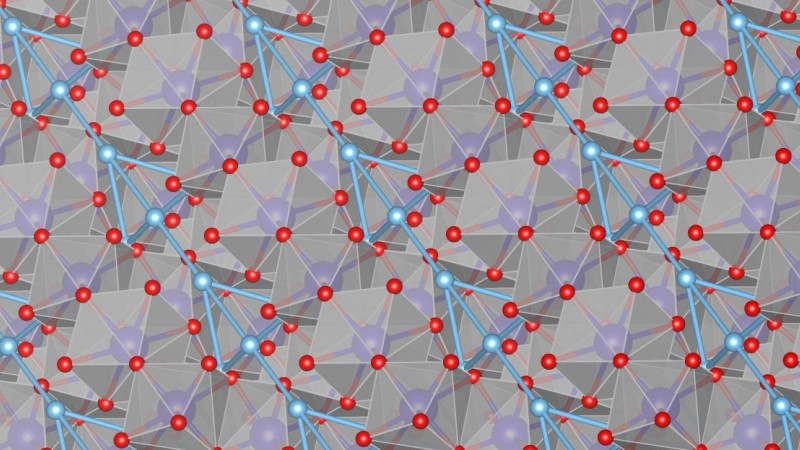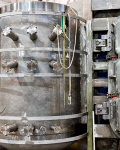A team at ORNL trained an artificial neural network to analyze scattering data for quantum materials discoveries
Scientists seek to use quantum materials—those that have correlated order at the subatomic level—for electronic devices, quantum computers, and superconductors. Quantum materials owe many of their properties to the physics that is occurring on the smallest scales, physics that is fully quantum mechanical.
Some materials, such as complex magnetic materials, share commonalities with quantum materials, and scientists can study these in an effort to better make sense of quantum materials and understand their ability to exist in many different electronic configurations. Understanding the interactions occurring within both quantum and complex magnetic materials, however, requires rigorous investigative methods.
One such method is neutron scattering, in which neutral particles called neutrons are scattered off a material to uncover its microscopic properties from the resulting interactions. However, reconstructing a material’s structure and properties proves to be challenging, even for seasoned experts.
For the first time, a team at the US Department of Energy’s (DOE’s) Oak Ridge National Laboratory (ORNL) is using artificial intelligence (AI) to find patterns in neutron scattering data that can lead to an understanding of the physics inside quantum or complex magnetic materials. Led by Alan Tennant, Initiative Lead for Quantum Materials at ORNL, the team recently trained an artificial neural network (ANN) to successfully interpret data from a neutron scattering experiment performed at ORNL’s Spallation Neutron Source (SNS). The team trained the network by feeding it data from neutron scattering simulations performed on systems at the Oak Ridge Leadership Computing Facility (OLCF), including the center’s decommissioned Cray XK7 Titan. One of the most powerful machines of its time, Titan continues to supply the scientific community with new discoveries even after its retirement last fall.
“Before, when you would do an experiment, you weren’t entirely sure you had the right result,” Tennant said. “With this neural network, we can be confident in the answer due to the extensive training that the network had to go through. Of all the possible cases it encounters, it can find the optimal solution.”
The network can reveal new information about current neutron scattering experiments and even provide insight into which experiments would be most beneficial to run in the future.
The results of the study were recently published in Nature Communications, and the team is continuing the work on the OLCF’s 200-petaflop IBM AC922 Summit, the world’s most powerful supercomputer.
Beyond human
When scientists perform neutron scattering experiments at SNS, they must account for the numerous possible scenarios that could have shaped the scattering pattern. Deciphering the neutrons that scatter off the material becomes a puzzle, and humans that have extensive experience with neutron scattering data have traditionally been relied on to form feasible hypotheses about the material’s structure based on the scattering patterns they see.
Researchers who perform these experiments can typically come up with many different scenarios for a material’s Hamiltonian, the expression of the material’s energy that completely describes its properties. But they can’t possibly account for every single one—especially in materials such as spin ices. Spin ices, magnetic analogues of ices, are thought to possess exotic magnetic states where north and south magnetic poles can separate and behave independently, something other magnets are unable to do. Determining the underlying interactions in these materials has proven to be very challenging, however.
Training an ANN, a type of machine learning that can analyze patterns in data and operates in a way similar to the neural networks in a human brain, is one possible solution.
“Humans can never go through all the scenarios, because there’s always ones you’ve never thought about,” said Anjana Samarakoon, a postdoctoral research associate at ORNL who worked closely with Tennant on the project. “But a computer can go through hundreds of thousands of scenarios and summarize the information for you. And so it becomes kind of dependable—it solves one of your big problems.”
The team trained an autoencoder—a type of ANN often used for compressing and recreating images—using tens of thousands of simulations (more than 50 billion calculations) on the supercomputing resources at the OLCF, a DOE Office of Science User Facility at ORNL. The team was able to simulate many more scenarios than a human is capable of examining. The team also found that the ANN filters out experimental noise to pull out only the most important information from the raw scattering data to recreate a material’s structure.
“It does what an expert does, but it does something far beyond,” Samarakoon said. “This can do ten thousand models instead of the simple 100 or so that a human can do.”
UT-Battelle LLC manages Oak Ridge National Laboratory for DOE’s Office of Science, the single largest supporter of basic research in the physical sciences in the United States. DOE’s Office of Science is working to address some of the most pressing challenges of our time. For more information, visit https://energy.gov/science.—by Rachel Harken







